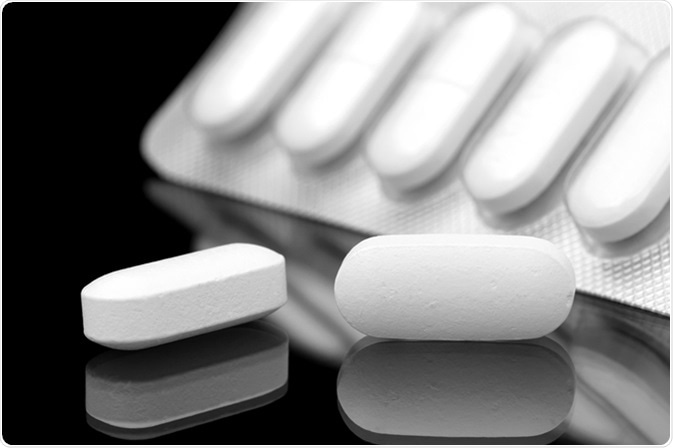Paracetamol is considered to be one of the most frequently used drugs around the world. Initially synthesized in 1878, this drug was introduced for limited medical use in 1883, and for wide unrestricted use after 1950s. Today, paracetamol is used by patients of practically all ages and for indications, and it is available over the counter.
Such wide utilization is primarily due to its proven antipyretic and analgesic actions. The spectrum of action of paracetamol is comparable to that of nonsteroidal anti-inflammatory drugs (NSAIDs), and its mechanism resembles that of the COX-2 selective inhibitors (i.e. drugs that directly inhibit cyclooxygenase-2, which is an enzyme responsible for pain and inflammation).

Paracetamol tablets. Image Credit: pelfophoto / Shutterstock
Mechanism of Action
On average, paracetamol is a weaker analgesic drug when compared to NSAIDs or the selective COX-2 inhibitors; however, it is often preferred due to its better tolerance. Regardless of its similarities to NSAIDs, its mechanism of action was formerly uncertain, although now it is commonly accepted that it inhibits both COX-1 and COX-2 enzymes through metabolism by utilizing the peroxidase function of aforementioned isoenzymes.
This in turn inhibits the formation of phenoxyl radicals from a tyrosine residue that is fundamental for COX-1 and COX-2 cyclooxygenase activity, as well as prostaglandin synthesis. Paracetamol often seems to have specific COX-2 selectivity, demonstrated by its satisfactory gastrointestinal tolerance and poor anti-platelet activity.
Furthermore, paracetamol selectively inhibits the synthesis of prostaglandins and related factors when low levels of peroxides and arachidonic acid are present; conversely, there is little activity at ample levels of these compounds. The end-result is the inability of paracetamol to suppress severe inflammation as occurs in acute gout and rheumatoid arthritis, but satisfactory activity in counteracting milder inflammation processes, mild to moderate pain, and for relieving fever.
Pharmacokinetics of Paracetamol
Paracetamol is well-absorbed from the gastrointestinal tract and readily inactivated in the liver by conjugation to its glucuronide and (to a lesser degree) sulfate. Any drug that is not conjugated is then metabolized by phase I microsomal enzymes to cytotoxic oxidative metabolites.
In infants and children, oral formulations are characterized by high bioavailability, with approximately 80% of the dose being absorbed (primarily by passive diffusion). Rectal formulations in this population show reduced bioavailability when compared to other routes of administration, and hence necessitate higher doses to achieve therapeutic effects.
Generally, the fastest action of paracetamol (occurring after fifteen minutes) is seen with fast-release tablets enriched with sodium bicarbonate that is known to enhance stomach emptying. When administered rectally in the form of suppositories, the bioavailability of paracetamol is substantially lower (approximately two-thirds in comparison to oral administration).
Paracetamol Toxicity
At appropriate dosages of paracetamol (i.e. maximum dose of 4 grams in 24 hours), no serious side effects have been observed, except the potential for allergic skin reactions. Regarding the latter, at the start of 2013 the United States Food and Drug Administration (US FDA) initiated continuous evaluation of this drug for adverse reactions.
Minor metabolites of paracetamol are also formed in the liver, of which N-acetyl-p-benzoquinone imine (NAPQI) can be toxic, but it is usually very quickly inactivated by glutathione sulfhydryl groups and subsequently excreted with urine as mercapturic acid. However, in the case of paracetamol overdose, this metabolite is not detoxified effectively and it may cause severe liver failure.
Clinical signs of hepatic damage (most notably abdominal pain, jaundice and hepatic tenderness) coupled with increased levels of liver enzymes are usually apparent 1-2 days after overdosing with paracetamol. Hepatic failure can ensue up to one week later and is best monitored by measuring the prothrombin time.
Specific therapeutic approaches involve replenishing the stores of liver glutathione, which conjugates NAPQI and, thus diminishes the amount available to harm the individual. As glutathione is poorly absorbed, its precursors are given instead (N-acetylcysteine and methionine). The earlier such therapy is introduced, the better the expected prognosis.
Further Reading
Last Updated: Feb 27, 2019